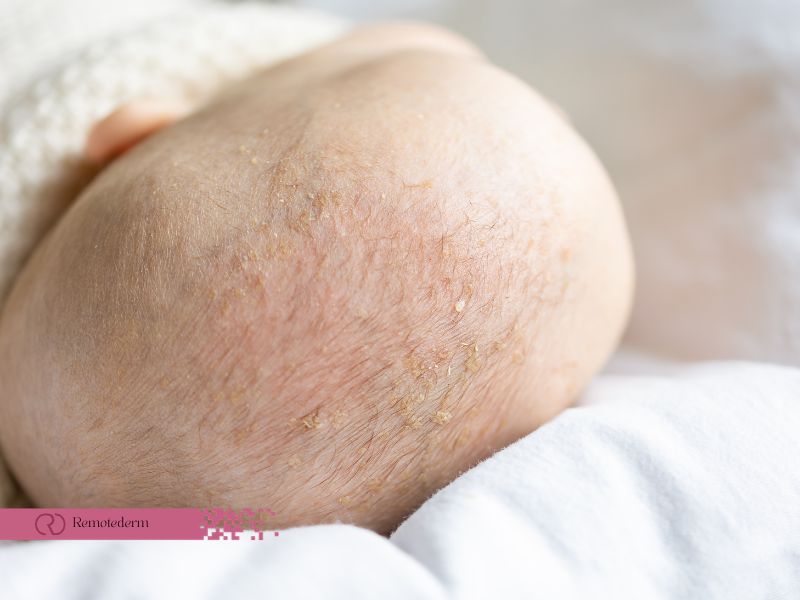Seborrheic dermatitis is a common skin condition that affects millions of people worldwide. It is characterized by redness, itching, and flaking of the skin and can be both uncomfortable and distressing. Fortunately, there are several treatment options for managing and alleviating the symptoms of seborrheic dermatitis. In this comprehensive guide, we will explore the best approaches for seborrheic dermatitis treatment, including its symptoms, differences from dandruff, and the role of online dermatology.
What is Seborrheic Dermatitis?
Seborrheic dermatitis is a chronic skin condition characterized by itchy, redness, and inflamed and scaly patches of skin. The scalp, face, ears, and upper chest are the most commonly affected areas because they have a high concentration of oil glands. While it can occur at any age, seborrheic dermatitis is most commonly seen in infants (where it is known as cradle cap) and adults aged 30 to 60.
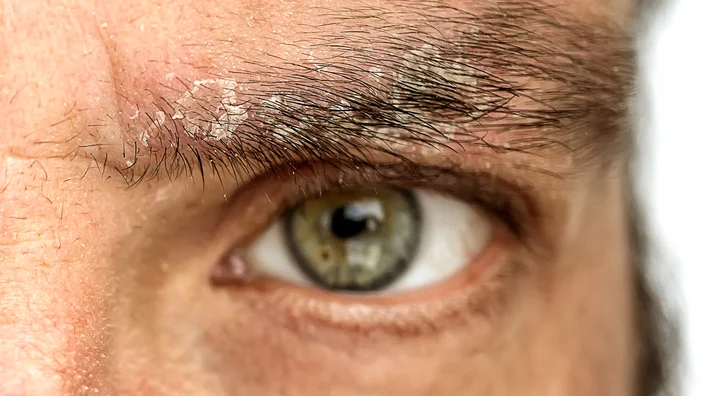
Causes of Seborrheic Dermatitis
To fully comprehend the complexities of seborrheic dermatitis, it is necessary to investigate its potential causes. While the precise cause is unknown, several factors are thought to have contributed to its emergence. Individuals with a family history of the condition may be more susceptible due to genetics. Hormonal fluctuations, especially during adolescence and adulthood, can also cause or worsen seborrheic dermatitis.
Furthermore, the presence of Malassezia yeast on the skin is thought to be a contributing factor. Stress, cold weather, specific skincare or haircare products, and even dietary factors can all act as triggers for flare-ups, making seborrheic dermatitis a multifaceted condition that necessitates a comprehensive approach to treatment. Understanding these potential causes can help people make informed decisions about their skincare routines and seek treatment when necessary.
Seborrheic Dermatitis Symptoms
Recognizing the symptoms of seborrheic dermatitis is the first step towards effective treatment. This skin condition can present with a range of uncomfortable and sometimes unsightly symptoms, which can vary in severity from person to person. Here’s a closer look at the common symptoms associated with seborrheic dermatitis:
- Flaking Skin
One of the hallmark signs of seborrheic dermatitis is the presence of flaky skin. This symptom can manifest as white or yellowish scales on the affected areas. These scales can be particularly noticeable on the scalp, eyebrows, and around the nose. The flakes are often larger and oilier compared to the smaller, dry flakes typically seen in dandruff.
- Redness and Inflammation
The affected skin areas may become red and inflamed, adding to the discomfort and itchiness experienced by individuals with seborrheic dermatitis. This redness and inflammation can be especially prominent on the face, particularly in the eyebrows, sides of the nose, and the skin behind the ears.
- Itching
Itching is a common and bothersome symptom of seborrheic dermatitis. The level of itching can vary from mild to intense and may worsen when the skin becomes dry or irritated. Constant scratching can lead to further inflammation and even open sores in severe cases.
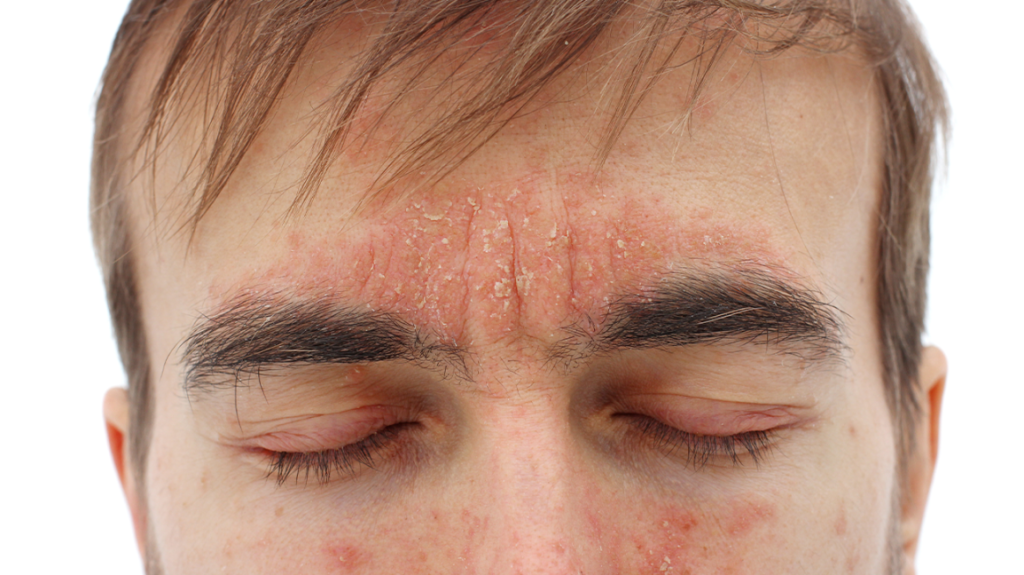
- Oily or Greasy Skin
Seborrheic dermatitis often occurs in areas of the body that have abundant sebaceous (oil) glands. Consequently, individuals with this condition often experience excessive oiliness in the affected areas. This excess oil can contribute to the development of scales and make the skin appear shiny or greasy.
- Cradle Cap in Infants
As mentioned, Seborrheic dermatitis can also affect infants, in which case it is commonly referred to as “cradle cap.” Infants with cradle caps may exhibit symptoms such as scaly patches on the scalp, which can sometimes extend to the face and diaper area. It’s important for parents to be aware of this condition and consult a paediatrician for guidance on management and treatment.
- Recurrence and Flare-Ups
Seborrheic dermatitis is often a chronic condition, and individuals may experience recurrent flare-ups. These flare-ups can be triggered by various factors, including stress, hormonal changes, cold and dry weather, and certain skincare or haircare products.
Seborrheic Dermatitis vs. Dandruff
When it comes to scalp and skin conditions, it’s easy to confuse one with another, especially when they share common symptoms like flaking skin. Seborrheic dermatitis and dandruff are two such conditions that often get mixed up, but it’s important to recognize that they are distinct in several key ways. Let’s delve into a detailed comparison to shed light on the differences:
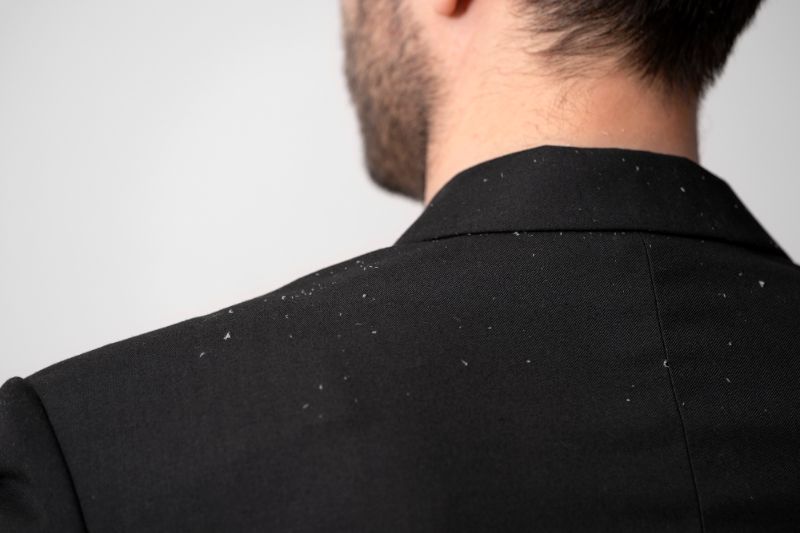
1. Location
- Dandruff
Dandruff primarily targets the scalp. It’s the classic culprit behind those pesky white flakes that can land on your shoulders or clothing, especially noticeable when you wear dark colours.
- Seborrheic Dermatitis
Seborrheic dermatitis, on the other hand, is not limited to the scalp alone. It’s an equal-opportunity skin condition that can make its presence known on various parts of the body, including the face, chest, and even behind the ears. This wider range of affected areas can sometimes make seborrheic dermatitis more challenging to manage.
2. Severity
- Dandruff
Dandruff is generally milder in comparison to seborrheic dermatitis. The flakes associated with dandruff are typically smaller, dry, and white or grey in colour. While it can cause some itchiness and irritation, it’s often less severe.
- Seborrheic Dermatitis
Seborrheic dermatitis tends to be more severe in nature. It sets itself apart with thicker, greasier scales on the skin. These scales can take on a yellowish or even a brownish hue. Additionally, redness and itching associated with seborrheic dermatitis are usually more pronounced and can be quite uncomfortable.
3. Chronic Nature
- Dandruff
Dandruff is often sporadic and occasional. Many people experience it from time to time, especially during certain weather conditions or due to changes in haircare routines. It can be managed with over-the-counter shampoos or home remedies.
- Seborrheic Dermatitis
Seborrheic dermatitis, on the other hand, tends to be a chronic condition. While it may have periods of remission, it often reoccurs. Managing seborrheic dermatitis may require more ongoing attention and potentially more intensive treatment options, especially if it affects areas beyond the scalp.
The Best Treatment Approaches
When it comes to managing seborrheic dermatitis, there is no one-size-fits-all solution. The most effective treatment plan often depends on the severity of the condition and individual factors. Here are some of the best approaches for seborrheic dermatitis treatment:
- Medicated Shampoos
Medicated shampoos containing active ingredients like ketoconazole, selenium sulfide, or salicylic acid can help control seborrheic dermatitis on the scalp. Regular use can help to reduce flakiness and itching.
- Topical Corticosteroids
A dermatologist may prescribe topical corticosteroids to reduce inflammation and redness in more severe cases. These should only be used under medical supervision because they can have negative side effects if not used correctly.
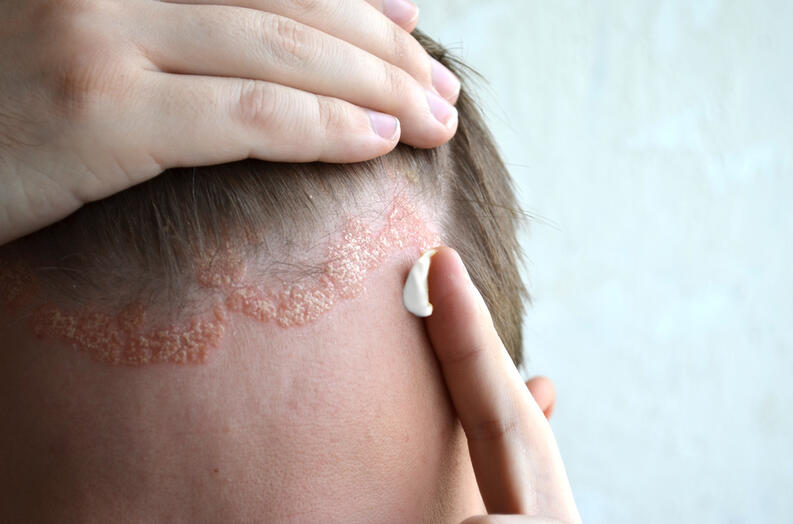
- Antifungal Creams
Since seborrheic dermatitis is believed to be linked to the growth of a specific yeast called Malassezia, antifungal creams or ointments can be beneficial in managing the condition.
- Moisturizers
Using a gentle, fragrance-free moisturizer can help soothe dry and flaky skin associated with seborrheic dermatitis. Choose products that are hypoallergenic and non-comedogenic.
- Lifestyle Changes
Making certain lifestyle changes can also help manage seborrheic dermatitis. These include:
- Reducing Stress: Because stress can aggravate skin conditions, stress-reduction techniques such as yoga or meditation may be beneficial.
- Avoiding Triggers: Determine and avoid triggers that aggravate your symptoms. Certain skincare products or dietary factors may fall into this category.
- Online Dermatology in Canada
In today’s digital age, online dermatology services have become increasingly accessible, even in Canada. These services allow individuals to consult with board-certified dermatologists remotely, providing a convenient way to receive expert guidance on managing seborrheic dermatitis and other skin conditions. Online dermatology Canada offers several advantages:
- Convenience
- Timely Access
- Prescriptions
Final Thoughts
Seborrheic dermatitis can be a challenging condition to manage, but with the right treatment approach, it is possible to alleviate its symptoms and improve your skin’s health. Remember that what works best for one person may not be suitable for another, so it’s essential to consult with a healthcare professional or dermatologist to create a personalized treatment plan. Whether you opt for medicated shampoos, topical corticosteroids, antifungal creams, or a combination of treatments, consistency is key.
In conclusion, seborrheic dermatitis treatment is not a one-size-fits-all solution. It requires patience, trial, and error to find the best approach for your unique skin. By understanding the symptoms, differentiating it from dandruff, and exploring various treatment options, you can take the first steps toward effectively managing seborrheic dermatitis and regaining your skin’s confidence.
FAQs
- Can I manage seborrheic dermatitis with lifestyle changes alone?
In some cases, lifestyle changes may be sufficient, but consulting a healthcare professional is recommended for a comprehensive treatment plan.
- Can online dermatologists prescribe medications for seborrheic dermatitis in Canada?
Yes, online dermatologists can prescribe medications and treatment plans, which can be picked up from local pharmacies.
- Are there potential side effects of using topical corticosteroids for seborrheic dermatitis?
Yes, topical corticosteroids should be used under medical supervision because they can have negative side effects if not used correctly.
- How do I distinguish seborrheic dermatitis from dandruff?
Seborrheic dermatitis scales are thicker and greasier, and they can affect various areas of the body beyond the scalp.
